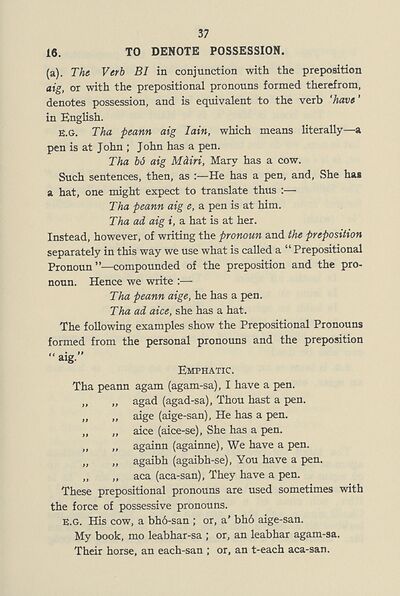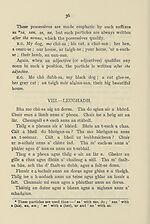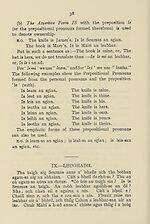Download files
Complete book:
Individual page:
Thumbnail gallery: Grid view | List view

37
16. TO DENOTE POSSESSION.
(a). The Verb BI in conjunction with the preposition
aig, or with the prepositional pronouns formed therefrom,
denotes possession, and is equivalent to the verb ‘have'
in English.
E.G. Tha peann aig lain, which means literally—a
pen is at John ; John has a pen.
Tha b6 aig Mdiri, Mary has a cow.
Such sentences, then, as :—He has a pen, and, She has
a hat, one might expect to translate thus :—
Tha peann aig e, a pen is at him.
Tha ad aig i, a hat is at her.
Instead, however, of writing the pronoun and the preposition
separately in this way we use what is called a “ Prepositional
Pronoun”—compounded of the preposition and the pro¬
noun. Hence we write :—
Tha peann aige, he has a pen.
Tha ad aice, she has a hat.
The following examples show the Prepositional Pronouns
formed from the personal pronouns and the preposition
“ aig.”
Emphatic.
Tha peann agam (agam-sa), I have a pen.
„ „ agad (agad-sa), Thou hast a pen.
„ „ aige (aige-san), He has a pen.
„ „ aice (aice-se), She has a pen.
„ ,, againn (againne), We have a pen.
„ „ agaibh (agaibh-se), You have a pen.
„ „ aca (aca-san), They have a pen.
These prepositional pronouns are used sometimes with
the force of possessive pronouns.
E.G. His cow, a bho-san ; or, a’ bh6 aige-san.
My book, mo leabhar-sa ; or, an leabhar agam-sa.
Their horse, an each-san ; or, an t-each aca-san.
16. TO DENOTE POSSESSION.
(a). The Verb BI in conjunction with the preposition
aig, or with the prepositional pronouns formed therefrom,
denotes possession, and is equivalent to the verb ‘have'
in English.
E.G. Tha peann aig lain, which means literally—a
pen is at John ; John has a pen.
Tha b6 aig Mdiri, Mary has a cow.
Such sentences, then, as :—He has a pen, and, She has
a hat, one might expect to translate thus :—
Tha peann aig e, a pen is at him.
Tha ad aig i, a hat is at her.
Instead, however, of writing the pronoun and the preposition
separately in this way we use what is called a “ Prepositional
Pronoun”—compounded of the preposition and the pro¬
noun. Hence we write :—
Tha peann aige, he has a pen.
Tha ad aice, she has a hat.
The following examples show the Prepositional Pronouns
formed from the personal pronouns and the preposition
“ aig.”
Emphatic.
Tha peann agam (agam-sa), I have a pen.
„ „ agad (agad-sa), Thou hast a pen.
„ „ aige (aige-san), He has a pen.
„ „ aice (aice-se), She has a pen.
„ ,, againn (againne), We have a pen.
„ „ agaibh (agaibh-se), You have a pen.
„ „ aca (aca-san), They have a pen.
These prepositional pronouns are used sometimes with
the force of possessive pronouns.
E.G. His cow, a bho-san ; or, a’ bh6 aige-san.
My book, mo leabhar-sa ; or, an leabhar agam-sa.
Their horse, an each-san ; or, an t-each aca-san.
Set display mode to:
![]() Universal Viewer |
Universal Viewer | ![]() Mirador |
Large image | Transcription
Mirador |
Large image | Transcription
| An Comunn Gàidhealach > An Comunn Gàidhealach Publications > Elementary course of Gaelic > (49) |
|---|
| Permanent URL | https://digital.nls.uk/196027387 |
|---|
| Description | This contains items published by An Comunn, which are not specifically Mòd-related. It includes journals, annual reports and corporate documents, policy statements, educational resources and published plays and literature. It is arranged alphabetically by title. |
|---|
| Description | A collection of over 400 items published by An Comunn Gàidhealach, the organisation which promotes Gaelic language and culture and organises the Royal National Mòd. Dating from 1891 up to the present day, the collection includes journals and newspapers, annual reports, educational materials, national Mòd programmes, published Mòd literature and music. |
|---|---|
| Additional NLS resources: |
|

